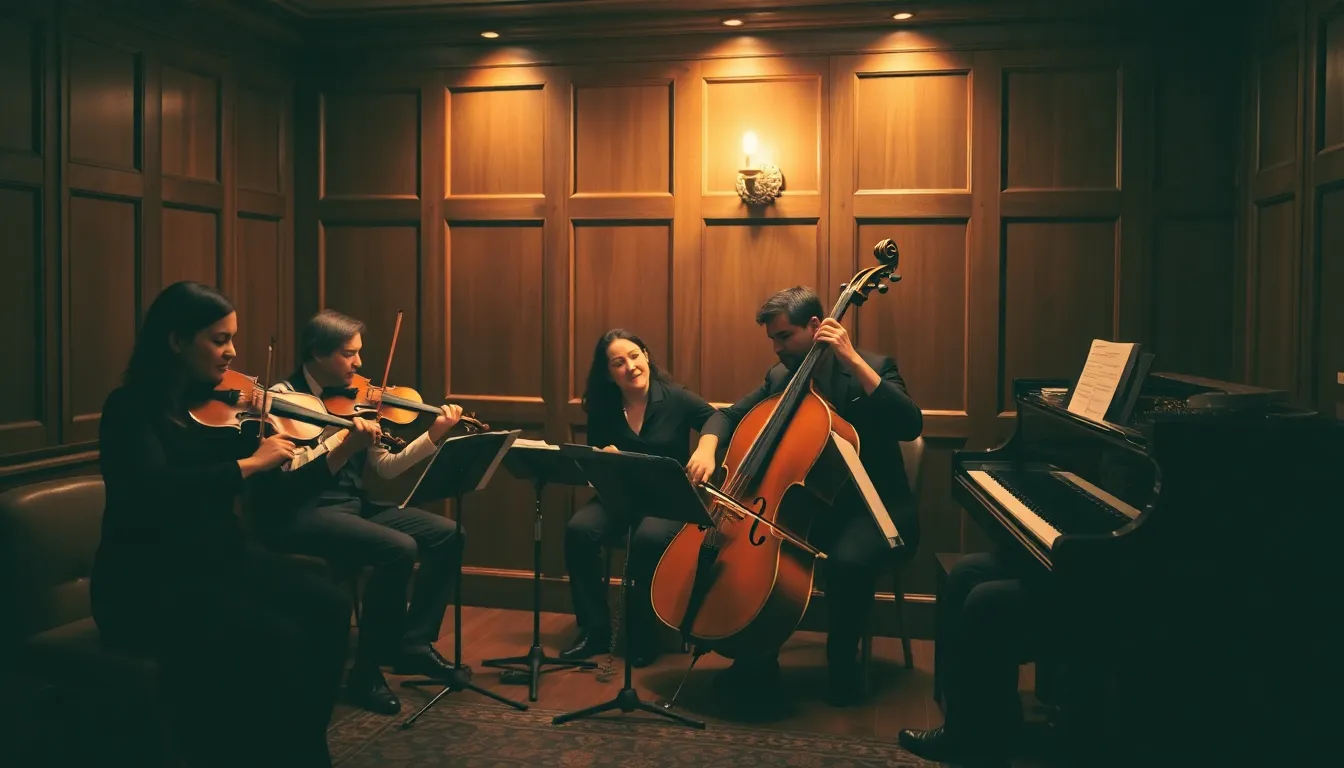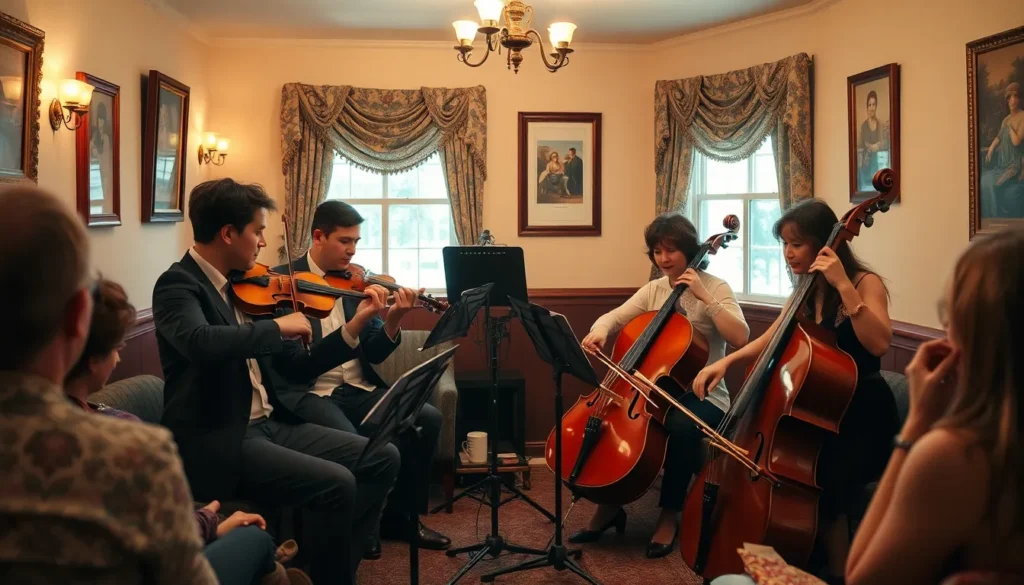Table of Contents
ToggleChamber music pieces are like the secret menu of the classical music world—deliciously intimate and often overlooked. Picture this: a handful of musicians huddled together, creating a sound that’s as rich and layered as a gourmet lasagna. Unlike orchestras that can sometimes feel like a chaotic symphony of chaos, chamber music offers a personal touch, inviting listeners into a cozy musical conversation.
Overview of Chamber Music Pieces
Chamber music pieces represent a blend of intimacy and complexity. Defined by small ensembles, these works allow musicians to collaborate closely, often resulting in a unique sound. String quartets, piano trios, and woodwind quintets are common formations, each bringing distinct textures to the music.
Notably, composers like Mozart, Beethoven, and Brahms have significantly contributed to the chamber music repertoire. The intricate layers within their compositions demonstrate a balance between individual expression and group dynamics. In each piece, composers explore themes, motifs, and harmonies that invite listeners into a rich auditory experience.
Performance settings often influence the nature of chamber music. Smaller venues create a more connected atmosphere, while larger spaces may diminish the personal touch. Each environment shapes how musicians interact, embodying the music’s conversational essence.
Audience engagement varies in chamber music pieces. Listeners experience a more direct connection to the performers, enhancing the emotional depth of each work. This accessibility allows for a deeper appreciation of nuanced interpretations and diverse styles.
Overall, the chamber music genre encompasses a wide range of emotions and techniques. Pieces range from the light-hearted to the profoundly moving, reflecting the versatility of its composers and performers. Such diversity ensures that chamber music remains a vital, evolving aspect of classical music that resonates with audiences today.
Popular Chamber Music Pieces

Chamber music pieces often showcase a range of emotional expressions and intricate musical conversations. They invite listeners into a unique auditory experience, reflecting both individual artistry and collaborative synergy.
Classical Selections
Classic chamber music selections feature works by renowned composers such as Mozart and Beethoven. Mozart’s String Quartet No. 15 and Beethoven’s Op. 59 quartets exemplify the genre’s delicate balance of harmony and counterpoint. In addition, Brahms’ Piano Quintet in F minor stands out for its rich textures and contrasting themes. Familiar pieces resonate with audiences through their memorable melodies and complex structures. Lists of favorites often include Schubert’s “Death and the Maiden” quartet and Dvořák’s “American” quartet, both celebrated for their lyrical beauty and vibrant rhythms.
Contemporary Works
Contemporary chamber music pieces explore innovative techniques and diverse styles. Composers like Jennifer Higdon and Steve Reich push boundaries with their unique approaches. Higdon’s “Cold Mountain” and Reich’s “Different Trains” illustrate modern themes and heightened emotional depth. Newer works emphasize improvisation and eclectic instrumentation, reflecting current musical trends. Ensemble configurations also diversify, with groups often incorporating electronic elements. These contemporary selections engage audiences with fresh perspectives while maintaining the intimacy characteristic of chamber music.
Composers of Chamber Music
Chamber music thrives on the creativity of its composers. Influential figures have shaped the genre’s rich tapestry over centuries.
Notable Classical Composers
Mozart, Beethoven, and Brahms stand at the forefront of classical chamber music. Mozart’s compositions, characterized by elegance and clarity, include exemplary works such as his String Quartet No. 15. Beethoven’s innovative Op. 59 quartets introduced complexity and depth, pushing the boundaries of traditional forms. Brahms’ Piano Quintet in F minor showcases emotional intensity and intricate counterpoint. These composers established a foundation that continues to inspire and inform contemporary chamber music.
Modern Innovators
Contemporary composers bring fresh perspectives and techniques to chamber music. Jennifer Higdon’s works often weave rich textures that captivate audiences. Steve Reich incorporates minimalist approaches, creating rhythmic and melodic patterns that resonate deeply. Both artists reflect current themes while preserving the intimacy inherent in chamber music. Their contributions illustrate the genre’s evolution and its ability to adapt to modern sensibilities.
Techniques in Chamber Music Composition
Chamber music composition employs various techniques that enhance its unique appeal. These techniques involve careful consideration of instrumentation and arrangement, as well as the effective use of dynamics and expression.
Instrumentation and Arrangement
Instrumentation in chamber music focuses on small ensembles. Typical groupings include string quartets, woodwind quintets, and mixed ensembles. Composers often choose instruments to create distinctive textures and tonal balances. Arrangements highlight individual voices while maintaining group cohesion. The interplay among musicians provides opportunities for dialogue and contrast, enriching the musical experience. Innovative combinations can lead to new soundscapes, pushing the boundaries of traditional chamber music.
The Role of Dynamics and Expression
Dynamics play a crucial role in conveying emotion and nuance in chamber music. Composers use crescendos and decrescendos to shape musical phrases. The contrast between loud and soft passages often heightens tension and resolution. Expression also stems from techniques such as articulation and phrasing. Musicians interpret markings to evoke feelings, connecting with audiences on a personal level. This emphasis on emotional delivery distinguishes chamber music from larger orchestral works, creating an intimate listening experience.
Chamber music stands as a testament to the power of intimate collaboration among musicians. Its unique ability to blend individual expression with collective harmony captivates audiences in a way that larger orchestral works often cannot. The genre’s rich history, marked by the contributions of legendary composers, continues to inspire both performers and listeners alike.
As contemporary composers infuse fresh ideas into the repertoire, chamber music remains a vibrant and evolving art form. The emotional depth and intricate conversations found in these pieces invite listeners to engage on a personal level, ensuring that chamber music will always hold a special place in the world of classical music.





